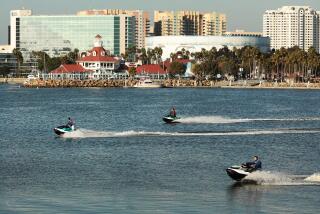Pico-Olympic plan revived
Despite fierce opposition from residents and concerns by two City Council members, Mayor Antonio Villaraigosa has ordered Los Angeles transportation officials to implement a plan to make Pico Boulevard mostly one-way eastbound, and Olympic Boulevard mostly one-way westbound.
Under the mayor’s plan, which had stalled earlier this week in a City Council committee, parking would be forbidden on all but a few stretches of Pico and Olympic during rush hour beginning March 8.
Traffic signals would be timed to favor faster eastbound traffic on Pico and westbound traffic on Olympic by April 28. After six months to a year, the two streets likely would be restriped so that Pico will have four lanes going east and two going west, while Olympic had four lanes going west and two going east, a spokesman for the mayor said Thursday.
The move comes a day after Councilmen Bill Rosendahl and Herb Wesson said they might remove their districts from the proposal because of concerns from local businesses and residents that the changes would harm shops and restaurants by making it impossible for customers to park.
On Thursday, the mayor, backed by Westside Councilman Jack Weiss, overrode the council’s Transportation Committee, which had postponed action on the plan, saying through a spokesman that the council did not have jurisdiction over such issues as parking regulations or whether streets were one-way.
“The Department of Transportation reports to the mayor,” said Matt Szabo, a spokesman for Villaraigosa.
The mayor reduced the size of the project by more than a mile.
It was initially supposed to run from the Santa Monica city limits to La Brea Avenue. Now, the idea is for it to end at Fairfax Avenue. The change is apparently a nod to Wesson, because the project no longer goes through a part of his district for which he expressed concerns.
Weiss’ strong support for the idea has come despite some heated opposition from merchants in the heavily Jewish Pico-Robertson district.
The mayor’s end-run around those council members underscores his effort to do something about Los Angeles’ gridlocked traffic, particularly on the Westside.
A spokesman for Wesson said the councilman did not know about the mayor’s move late Thursday and could not comment.
Wesson just Wednesday said he would submit a motion to make the program’s eastern terminus be Fairfax Avenue -- effectively removing most of his district. Villaraigosa’s plan seems to address that issue.
But the mayor did not address the concerns raised by Rosendahl, who had demanded Wednesday that the Department of Transportation confer with city planners before moving forward on such a drastic reordering of streets. Rosendahl had threatened to remove his district -- which is west of the San Diego Freeway -- from the proposal if city planners were not consulted.
“It’s unfortunate that the planning department is not going to be engaged,” Rosendahl said. “Planning and transportation should be joined at the hip. . . . You just don’t bowl over the community like that. You have to appreciate who’s there. It’s disrespectful to my constituents and it’s an insult to my constituents.”
Hundreds of residents and businesses along the two streets oppose the plan. Many say removing parking from Pico during peak hours will kill businesses and ruin the pedestrian nature of the street.
Anticipating the protest, transportation officials scaled back the hours of the proposal and have offered to allow some parking -- mostly in the districts of two councilmen who have opposed the plan.
Transportation officials Thursday hustled to restart the plan, and by day’s end Villaraigosa deputy Jaime De La Vega had sent a memo to transportation chief Rita Robinson ordering her to begin implementing it.
Word of the mayor’s order spread quickly among residents and business owners who oppose it.
“We were promised answers to our questions,” said Mike Eveloff, president of Tract 7260, a homeowners group near Century City. “We have not gotten those answers. There has been no meaningful input, and now the plan is happening anyway.”
Weiss’ support of the plan has generated significant ire among constituents, who styled themselves as “District 5 Orphans” at a City Council committee hearing on the matter Wednesday.
Weiss also received a veiled jab from Rosendahl at the hearing: If both he and Wesson pulled out, Rosendahl told transportation officials, “You can keep it in the 5th District.”
Weiss struck back Thursday, saying that the changes were for the good of the city as a whole.
“The quarter-million people of my district and the 4 million people of this city want immediate traffic relief,” Weiss said. “So this should not be about the parochial interests of a few -- it should be about what’s good for the whole city.”
Under the current plan, Pico would have three eastbound lanes during rush hour because the parking lane on that side would become a traffic lane. Parts of the northern side of the street -- used by westbound traffic -- would continue to have parking, so there would only be two lanes in that direction in some spots.
Olympic would gain an extra westbound lane in the same manner. Both streets already have significant parking restrictions in place along some stretches, but not along the entire route.
In six months to a year, if the program is working and conditions warrant it, the two streets would be restriped to allow for even more one-way traffic and parking restrictions would be tighter, Szabo said.
--
Times staff writer Martha Groves contributed to this report.
More to Read
Sign up for Essential California
The most important California stories and recommendations in your inbox every morning.
You may occasionally receive promotional content from the Los Angeles Times.










